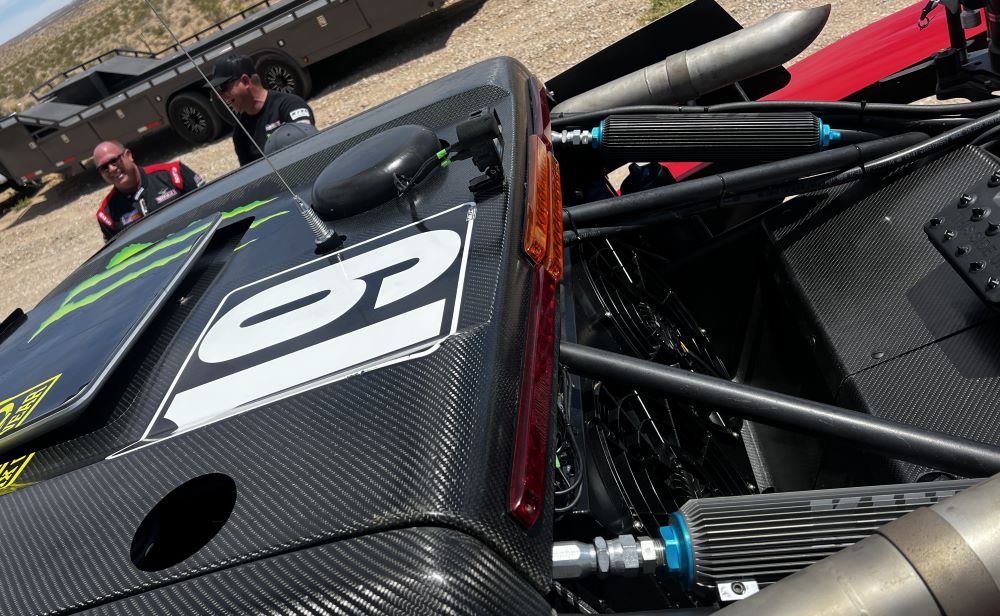
If you happened to catch streaming coverage of the recently completed BFGoodrich SCORE Baja 1000, off-road racing’s newest technology was front and center for those knowing not what they were watching, but how it was possible in the first place.
For hours, SCORE’s production group provided viewers real time live in-car coverage shot in the middle of Baja’s vast wilderness, all without a cell tower or relay helicopter in sight. At one point the production cut to a live shot from inside Rob MacCachren’s chase team located on a highway directly behind the race-winning McMillin Racing Trophy-Truck. The SCORE in-studio announcing team was able to speak directly with MacCachren’s wife Amber, who was giving updates in real time from the chase truck.
In-car cameras are certainly not new, but the ability to connect cameras, voice and data from some of the world’s most remote locations is. All of it can be attributed to off-road racing’s increasing use of the Starlink satellite communications system engineered and marketed by SpaceX. First adopted by the marine and RV industries, the mobile Starlink units have seen a strong uptick in use by desert racing teams to greatly improve communications between race vehicles, chase teams and crew members. With direct internet access, all the old radio (with relays perched high on mountain tops or planes) and satellite phone technology is quickly becoming a thing of the past.
The advent of installing the Starlink units on to the race vehicles themselves is a newer trend as advancements in products specifically made for this application come to market. PCI Race Radios, for example, now sells complete installation kits for the Starlink Gen 2, Gen 3 and the recently released Starlink Mini that includes custom mounts that house the dish itself and protects it from water, dust and vibration. The units can use a magnetic mount or incorporated into solid mounts on a steel chassis or roll cage.
The key development in transforming Starlink connectivity into a live streaming service provider is the invention of the Star Stream system. Invented by California-based Star Stream company founder George Hammel, a patent-pending control unit named the StreamBox Pro takes input from two GoPro camer as and re-streams the feed to content production trucks or directly to social media platforms.
Racers can use the StreamBox Pro to switch camera angles, add image overlays and provide their feeds to a dedicated profile on Star Stream to send private coverage links directly to team members, sponsors, friends and family.
A primary example leading teams creating their own relevant content is 1Nine Industries, a top manufacturer of Trophy Trucks based in Fountain Valley, Calif. Formerly Herbst-Smith Fabrication, in recent years the rebranded company has expanded from a private operation for the legendary Herbst off-road family of Nevada to providing turn-key vehicles, maintenance and race support for a variety of customers.
1Nine Industries and the Herbst family is not only providing a testing platform to perfect the technology, but also important funding to create proof of concept. Together with cinematographer Bryan Moore, the team integrated the use of the Star Stream system and live helicopter coverage to provide real time coverage of 1Nine Industries’ racing desert racing efforts in Baja and the U.S. All the camera footage is streamed directly to Star Stream’s production studios and cut live with graphics for hours of streaming content.
The result has been nothing short of impressive, producing 75,000,000 Terrible Herbst Motorsports social media views in 2024. As verified by sponsorship analytics company Hookit, the live Herbst Motorsports live racing experience and social media generated 63.8 million impressions on Instagram and 18.5 million on YouTube.
“That’s a big number, isn’t it?” enthused 1Nine Industries and Terrible Herbst Motorsports President Ryan Arciero. “Now everything is in real time, and we have never had access like that before. It’s changed everything for the better, and our sport’s future has blown wide open.”